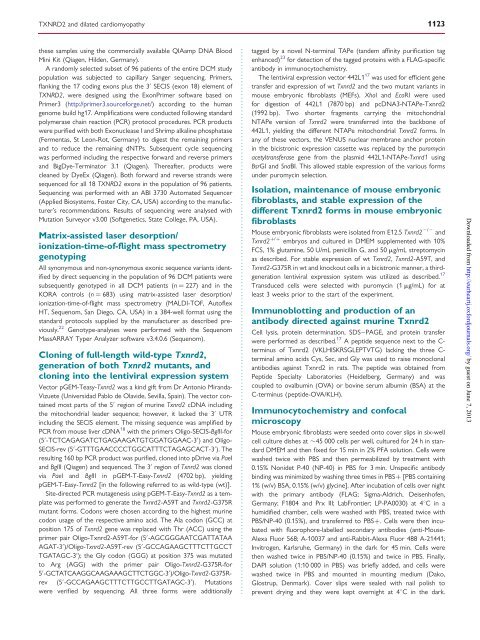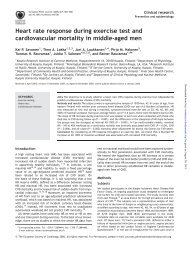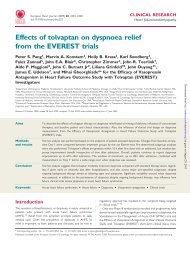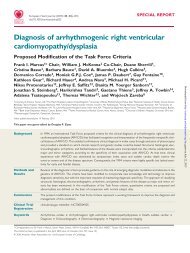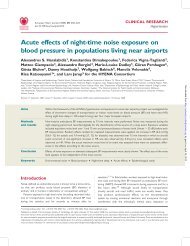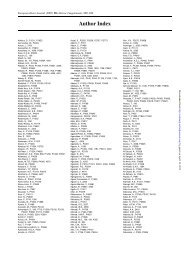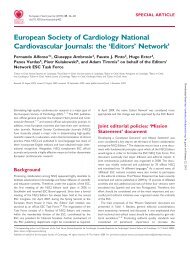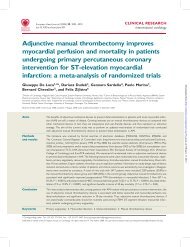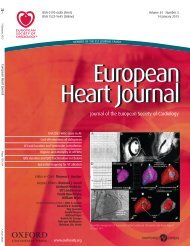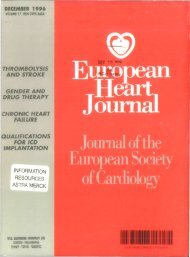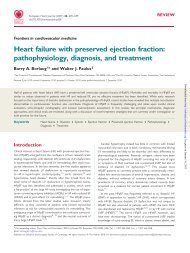Mutations in the mitochondrial thioredoxin reductase gene TXNRD2 ...
Mutations in the mitochondrial thioredoxin reductase gene TXNRD2 ...
Mutations in the mitochondrial thioredoxin reductase gene TXNRD2 ...
You also want an ePaper? Increase the reach of your titles
YUMPU automatically turns print PDFs into web optimized ePapers that Google loves.
<strong>TXNRD2</strong> and dilated cardiomyopathy 1123<br />
<strong>the</strong>se samples us<strong>in</strong>g <strong>the</strong> commercially available QIAamp DNA Blood<br />
M<strong>in</strong>i Kit (Qiagen, Hilden, Germany).<br />
A randomly selected subset of 96 patients of <strong>the</strong> entire DCM study<br />
population was subjected to capillary Sanger sequenc<strong>in</strong>g. Primers,<br />
flank<strong>in</strong>g <strong>the</strong> 17 cod<strong>in</strong>g exons plus <strong>the</strong> 3 ′ SECIS (exon 18) element of<br />
<strong>TXNRD2</strong>, were designed us<strong>in</strong>g <strong>the</strong> ExonPrimer software based on<br />
Primer3 (http://primer3.sourceforge.net/) accord<strong>in</strong>g to <strong>the</strong> human<br />
genome build hg17. Amplifications were conducted follow<strong>in</strong>g standard<br />
polymerase cha<strong>in</strong> reaction (PCR) protocol procedures. PCR products<br />
were purified with both Exonuclease I and Shrimp alkal<strong>in</strong>e phosphatase<br />
(Fermentas, St Leon-Rot, Germany) to digest <strong>the</strong> rema<strong>in</strong><strong>in</strong>g primers<br />
and to reduce <strong>the</strong> rema<strong>in</strong><strong>in</strong>g dNTPs. Subsequent cycle sequenc<strong>in</strong>g<br />
was performed <strong>in</strong>clud<strong>in</strong>g <strong>the</strong> respective forward and reverse primers<br />
and BigDye-Term<strong>in</strong>ator 3.1 (Qiagen). Thereafter, products were<br />
cleaned by DyeEx (Qiagen). Both forward and reverse strands were<br />
sequenced for all 18 <strong>TXNRD2</strong> exons <strong>in</strong> <strong>the</strong> population of 96 patients.<br />
Sequenc<strong>in</strong>g was performed with an ABI 3730 Automated Sequencer<br />
(Applied Biosystems, Foster City, CA, USA) accord<strong>in</strong>g to <strong>the</strong> manufacturer’s<br />
recommendations. Results of sequenc<strong>in</strong>g were analysed with<br />
Mutation Surveyor v3.00 (Soft<strong>gene</strong>tics, State College, PA, USA).<br />
Matrix-assisted laser desorption/<br />
ionization-time-of-flight mass spectrometry<br />
genotyp<strong>in</strong>g<br />
All synonymous and non-synonymous exonic sequence variants identified<br />
by direct sequenc<strong>in</strong>g <strong>in</strong> <strong>the</strong> population of 96 DCM patients were<br />
subsequently genotyped <strong>in</strong> all DCM patients (n ¼ 227) and <strong>in</strong> <strong>the</strong><br />
KORA controls (n ¼ 683) us<strong>in</strong>g matrix-assisted laser desorption/<br />
ionization-time-of-flight mass spectrometry (MALDI-TOF, Autoflex<br />
HT, Sequenom, San Diego, CA, USA) <strong>in</strong> a 384-well format us<strong>in</strong>g <strong>the</strong><br />
standard protocols supplied by <strong>the</strong> manufacturer as described previously.<br />
22 Genotype-analyses were performed with <strong>the</strong> Sequenom<br />
MassARRAY Typer Analyzer software v3.4.0.6 (Sequenom).<br />
Clon<strong>in</strong>g of full-length wild-type Txnrd2,<br />
<strong>gene</strong>ration of both Txnrd2 mutants, and<br />
clon<strong>in</strong>g <strong>in</strong>to <strong>the</strong> lentiviral expression system<br />
Vector pGEM-Teasy-Txnrd2 was a k<strong>in</strong>d gift from Dr Antonio Miranda-<br />
Vizuete (Universidad Pablo de Olavide, Sevilla, Spa<strong>in</strong>). The vector conta<strong>in</strong>ed<br />
most parts of <strong>the</strong> 5 ′ region of mur<strong>in</strong>e Txnrd2 cDNA <strong>in</strong>clud<strong>in</strong>g<br />
<strong>the</strong> <strong>mitochondrial</strong> leader sequence; however, it lacked <strong>the</strong> 3 ′ UTR<br />
<strong>in</strong>clud<strong>in</strong>g <strong>the</strong> SECIS element. The miss<strong>in</strong>g sequence was amplified by<br />
PCR from mouse liver cDNA 18 with <strong>the</strong> primers Oligo-SECIS-BglII-for<br />
(5 ′ -TCTCAGAGATCTGAGAAGATGTGGATGGAAC-3 ′ ) and Oligo-<br />
SECIS-rev (5 ′ -GTTTGAACCCCTGGCATTTCTAGAGCACT-3 ′ ). The<br />
result<strong>in</strong>g 160 bp PCR product was purified, cloned <strong>in</strong>to pDrive via PaeI<br />
and BglII (Qiagen) and sequenced. The 3 ′ region of Txnrd2 was cloned<br />
via PaeI and BglII <strong>in</strong> pGEM-T-Easy-Txnrd2 (4702 bp), yield<strong>in</strong>g<br />
pGEM-T-Easy-Txnrd2 [<strong>in</strong> <strong>the</strong> follow<strong>in</strong>g referred to as wild-type (wt)].<br />
Site-directed PCR muta<strong>gene</strong>sis us<strong>in</strong>g pGEM-T-Easy-Txnrd2 as a template<br />
was performed to <strong>gene</strong>rate <strong>the</strong> Txnrd2-A59T and Txnrd2-G375R<br />
mutant forms. Codons were chosen accord<strong>in</strong>g to <strong>the</strong> highest mur<strong>in</strong>e<br />
codon usage of <strong>the</strong> respective am<strong>in</strong>o acid. The Ala codon (GCC) at<br />
position 175 of Txnrd2 <strong>gene</strong> was replaced with Thr (ACC) us<strong>in</strong>g <strong>the</strong><br />
primer pair Oligo-Txnrd2-A59T-for (5 ′ -AGCGGGAATCGATTATAA<br />
AGAT-3 ′ )/Oligo-Txnrd2-A59T-rev (5 ′ -GCCAGAAGCTTTCTTGCCT<br />
TGATAGC-3 ′ ); <strong>the</strong> Gly codon (GGG) at position 375 was mutated<br />
to Arg (AGG) with <strong>the</strong> primer pair Oligo-Txnrd2-G375R-for<br />
5 ′ -GCTATCAAGGCAAGAAAGCTTCTGGC-3 ′ )/Oligo-Txnrd2-G375Rrev<br />
(5 ′ -GCCAGAAGCTTTCTTGCCTTGATAGC-3 ′ ). <strong>Mutations</strong><br />
were verified by sequenc<strong>in</strong>g. All three forms were additionally<br />
tagged by a novel N-term<strong>in</strong>al TAPe (tandem aff<strong>in</strong>ity purification tag<br />
enhanced) 23 for detection of <strong>the</strong> tagged prote<strong>in</strong>s with a FLAG-specific<br />
antibody <strong>in</strong> immunocytochemistry.<br />
The lentiviral expression vector 442L1 17 was used for efficient <strong>gene</strong><br />
transfer and expression of wt Txnrd2 and <strong>the</strong> two mutant variants <strong>in</strong><br />
mouse embryonic fibroblasts (MEFs). XhoI and EcoRI were used<br />
for digestion of 442L1 (7870 bp) and pcDNA3-NTAPe-Txnrd2<br />
(1992 bp). Two shorter fragments carry<strong>in</strong>g <strong>the</strong> <strong>mitochondrial</strong><br />
NTAPe version of Txnrd2 were transferred <strong>in</strong>to <strong>the</strong> backbone of<br />
442L1, yield<strong>in</strong>g <strong>the</strong> different NTAPe <strong>mitochondrial</strong> Txnrd2 forms. In<br />
any of <strong>the</strong>se vectors, <strong>the</strong> VENUS nuclear membrane anchor prote<strong>in</strong><br />
<strong>in</strong> <strong>the</strong> bicistronic expression cassette was replaced by <strong>the</strong> puromyc<strong>in</strong><br />
acetyltransferase <strong>gene</strong> from <strong>the</strong> plasmid 442L1-NTAPe-Txnrd1 us<strong>in</strong>g<br />
BsrGI and SnaBI. This allowed stable expression of <strong>the</strong> various forms<br />
under puromyc<strong>in</strong> selection.<br />
Isolation, ma<strong>in</strong>tenance of mouse embryonic<br />
fibroblasts, and stable expression of <strong>the</strong><br />
different Txnrd2 forms <strong>in</strong> mouse embryonic<br />
fibroblasts<br />
Mouse embryonic fibroblasts were isolated from E12.5 Txnrd2 2/2 and<br />
Txnrd2 +/+ embryos and cultured <strong>in</strong> DMEM supplemented with 10%<br />
FCS, 1% glutam<strong>in</strong>e, 50 U/mL penicill<strong>in</strong> G, and 50 mg/mL streptomyc<strong>in</strong><br />
as described. For stable expression of wt Txnrd2, Txnrd2-A59T, and<br />
Txnrd2-G375R <strong>in</strong> wt and knockout cells <strong>in</strong> a bicistronic manner, a third<strong>gene</strong>ration<br />
lentiviral expression system was utilized as described. 17<br />
Transduced cells were selected with puromyc<strong>in</strong> (1 mg/mL) for at<br />
least 3 weeks prior to <strong>the</strong> start of <strong>the</strong> experiment.<br />
Immunoblott<strong>in</strong>g and production of an<br />
antibody directed aga<strong>in</strong>st mur<strong>in</strong>e Txnrd2<br />
Cell lysis, prote<strong>in</strong> determ<strong>in</strong>ation, SDS–PAGE, and prote<strong>in</strong> transfer<br />
were performed as described. 17 A peptide sequence next to <strong>the</strong> Cterm<strong>in</strong>us<br />
of Txnrd2 (VKLHISKRSGLEPTVTG) lack<strong>in</strong>g <strong>the</strong> three Cterm<strong>in</strong>al<br />
am<strong>in</strong>o acids Cys, Sec, and Gly was used to raise monoclonal<br />
antibodies aga<strong>in</strong>st Txnrd2 <strong>in</strong> rats. The peptide was obta<strong>in</strong>ed from<br />
Peptide Specialty Laboratories (Heidelberg, Germany) and was<br />
coupled to ovalbum<strong>in</strong> (OVA) or bov<strong>in</strong>e serum album<strong>in</strong> (BSA) at <strong>the</strong><br />
C-term<strong>in</strong>us (peptide-OVA/KLH).<br />
Immunocytochemistry and confocal<br />
microscopy<br />
Mouse embryonic fibroblasts were seeded onto cover slips <strong>in</strong> six-well<br />
cell culture dishes at ≏45 000 cells per well, cultured for 24 h <strong>in</strong> standard<br />
DMEM and <strong>the</strong>n fixed for 15 m<strong>in</strong> <strong>in</strong> 2% PFA solution. Cells were<br />
washed twice with PBS and <strong>the</strong>n permeabilized by treatment with<br />
0.15% Nonidet P-40 (NP-40) <strong>in</strong> PBS for 3 m<strong>in</strong>. Unspecific antibody<br />
b<strong>in</strong>d<strong>in</strong>g was m<strong>in</strong>imized by wash<strong>in</strong>g three times <strong>in</strong> PBS+ [PBS conta<strong>in</strong><strong>in</strong>g<br />
1% (w/v) BSA, 0.15% (w/v) glyc<strong>in</strong>e]. After <strong>in</strong>cubation of cells over night<br />
with <strong>the</strong> primary antibody (FLAG; Sigma-Aldrich, Deisenhofen,<br />
Germany; F1804 and Prx III; LabFrontier; LP-PA0030) at 48C <strong>in</strong> a<br />
humidified chamber, cells were washed with PBS, treated twice with<br />
PBS/NP-40 (0.15%), and transferred to PBS+. Cells were <strong>the</strong>n <strong>in</strong>cubated<br />
with fluorophore-labelled secondary antibodies (anti-Mouse-<br />
Alexa Fluor 568; A-10037 and anti-Rabbit-Alexa Fluor 488 A-21441;<br />
Invitrogen, Karlsruhe, Germany) <strong>in</strong> <strong>the</strong> dark for 45 m<strong>in</strong>. Cells were<br />
<strong>the</strong>n washed twice <strong>in</strong> PBS/NP-40 (0.15%) and twice <strong>in</strong> PBS. F<strong>in</strong>ally,<br />
DAPI solution (1:10 000 <strong>in</strong> PBS) was briefly added, and cells were<br />
washed twice <strong>in</strong> PBS and mounted <strong>in</strong> mount<strong>in</strong>g medium (Dako,<br />
Glostrup, Denmark). Cover slips were sealed with nail polish to<br />
prevent dry<strong>in</strong>g and <strong>the</strong>y were kept overnight at 48C <strong>in</strong> <strong>the</strong> dark.<br />
Downloaded from<br />
http://eurheartj.oxfordjournals.org/ by guest on June 7, 2013


